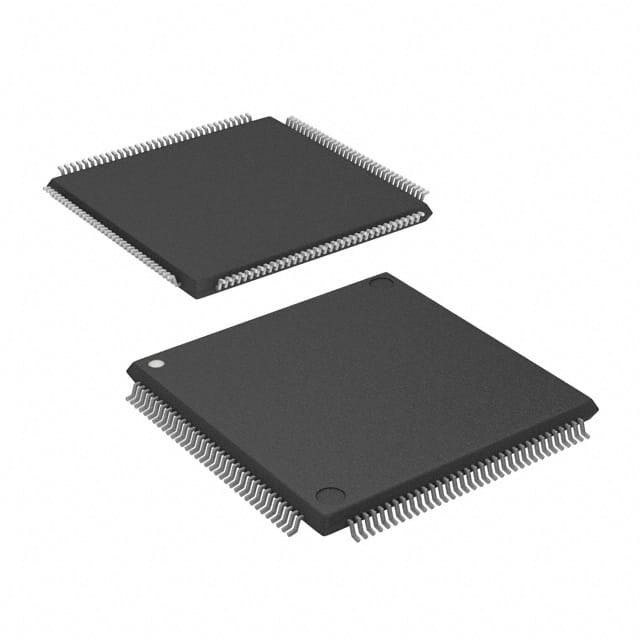TMS320C50PGE57
Overview
Product Category
TMS320C50PGE57 belongs to the category of digital signal processors (DSPs).
Use
This product is primarily used for processing and manipulating digital signals in various applications such as telecommunications, audio and video processing, control systems, and image processing.
Characteristics
- High-performance DSP with advanced features
- Efficient execution of complex algorithms
- Low power consumption
- Real-time processing capabilities
- Integrated peripherals for enhanced functionality
Package
TMS320C50PGE57 is available in a compact and durable package, ensuring easy integration into electronic systems.
Essence
The essence of TMS320C50PGE57 lies in its ability to perform high-speed digital signal processing tasks with precision and efficiency.
Packaging/Quantity
This product is typically packaged individually and is available in various quantities depending on the requirements of the application.
Specifications
- Architecture: Harvard architecture
- Clock Speed: 50 MHz
- Data Bus Width: 16 bits
- Instruction Set: Modified Harvard architecture instruction set
- Memory: On-chip RAM and ROM
- I/O Interfaces: Serial ports, parallel ports, timers, interrupt controller
- Power Supply: 3.3V
Detailed Pin Configuration
- VCC - Power supply voltage
- GND - Ground
- RESET - Reset pin
- CLKIN - External clock input
- CLKOUT - Clock output
- A0-A15 - Address bus
- D0-D15 - Data bus
- INT - Interrupt pin
- RD - Read control
- WR - Write control
- CS - Chip select
- WAIT - Wait state control
- DMA - Direct memory access control
- XINT - External interrupt
- XDACK - External DMA acknowledge
- XRDY - External ready
Functional Features
- High-speed arithmetic and logic operations
- Efficient multiply-accumulate (MAC) instructions
- On-chip memory for data storage and program execution
- Multiple I/O interfaces for seamless integration with external devices
- Interrupt handling mechanism for real-time processing
- Direct memory access (DMA) support for efficient data transfer
Advantages and Disadvantages
Advantages
- High-performance DSP capabilities
- Low power consumption
- Real-time processing capabilities
- Integrated peripherals simplify system design
- Efficient execution of complex algorithms
Disadvantages
- Limited availability of alternative models
- May require specialized knowledge for programming and optimization
Working Principles
TMS320C50PGE57 operates on the principles of digital signal processing, utilizing its high-speed arithmetic and logic units to perform mathematical operations on digital signals. It follows a Harvard architecture, allowing simultaneous instruction fetch and data access. The processor executes instructions stored in its on-chip memory, manipulating data and producing desired outputs.
Detailed Application Field Plans
TMS320C50PGE57 finds applications in various fields, including:
- Telecommunications: Signal processing in communication systems, such as voice and data transmission.
- Audio and Video Processing: Real-time audio and video processing for multimedia applications.
- Control Systems: Implementation of control algorithms in industrial automation and robotics.
- Image Processing: Manipulation and analysis of digital images for medical imaging, surveillance, and computer vision.
Detailed and Complete Alternative Models
While TMS320C50PGE57 is a highly capable DSP, there are alternative models available in the market that offer similar functionality. Some notable alternatives include:
- TMS320C54x series by Texas Instruments
- ADSP-21xx series by Analog Devices
- SHARC series by Analog Devices
These alternative models provide a range of options for developers based on their specific requirements and preferences.
In conclusion, TMS320C50PGE57 is a powerful digital signal processor designed for high-performance signal processing applications. Its efficient execution of complex algorithms, low power consumption, and integrated peripherals make it a versatile choice for various industries. While it may have limited availability of alternative models, its advantages outweigh the disadvantages, making it a popular choice among developers in the field of digital signal processing.
Lista 10 Vanliga frågor och svar relaterade till tillämpningen av TMS320C50PGE57 i tekniska lösningar
What is TMS320C50PGE57?
- TMS320C50PGE57 is a digital signal processor (DSP) manufactured by Texas Instruments, commonly used in audio and speech processing applications.
What are the key features of TMS320C50PGE57?
- The TMS320C50PGE57 features a 16-bit fixed-point DSP core, on-chip memory, and various peripherals for interfacing with external components.
How is TMS320C50PGE57 typically used in technical solutions?
- TMS320C50PGE57 is often used in technical solutions for tasks such as audio filtering, speech recognition, and telecommunication signal processing.
What programming languages are commonly used to program TMS320C50PGE57?
- Assembly language and C/C++ are commonly used to program TMS320C50PGE57.
What are the power requirements for TMS320C50PGE57?
- TMS320C50PGE57 typically operates at a supply voltage of 5V and consumes varying amounts of power depending on the application and clock frequency.
Can TMS320C50PGE57 be used in real-time applications?
- Yes, TMS320C50PGE57 is well-suited for real-time applications due to its high processing speed and efficient architecture.
What are the typical clock speeds for TMS320C50PGE57?
- TMS320C50PGE57 can operate at clock speeds ranging from 20 MHz to 50 MHz, depending on the specific model and configuration.
Are there any development tools available for TMS320C50PGE57?
- Yes, Texas Instruments provides a range of development tools, including compilers, debuggers, and evaluation modules, to aid in the development of applications for TMS320C50PGE57.
What are the common challenges when working with TMS320C50PGE57?
- Some common challenges include optimizing code for performance, managing memory efficiently, and interfacing with external hardware.
Are there any alternative DSPs that can be considered alongside TMS320C50PGE57?
- Yes, alternatives such as TMS320C55PGE57 and TMS320C67PGE57 offer different performance characteristics and feature sets that may be suitable for specific applications.


